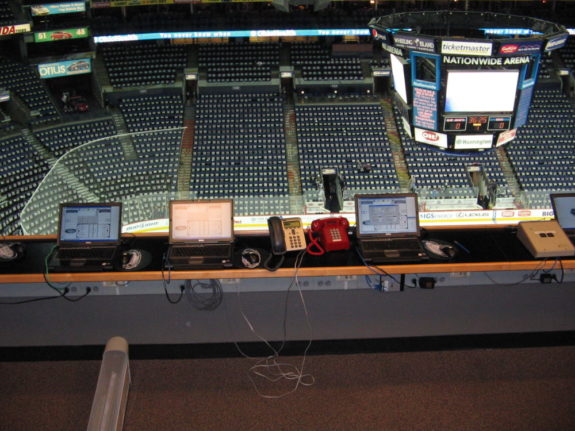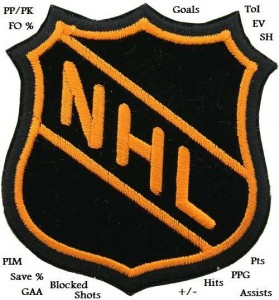By Rick Gethin
“On any given night, we have over 200+ years of hockey experience working each game” ~ NHL off-ice Crew Supervisor Don Supelak
When most hockey fans go to a game, they most likely are not thinking of the off-ice officiating crew that keeps track of all of the statistics of their most beloved skaters. Where is my seat?, where is the closest food vendor? and are we going to win? are likely the most asked questions, and not necessarily in that order. And all fans can see the Referees’ and Linesmen in their zebra-stripe uniforms on the ice. To some, they might think that those four guys are the only NHL officials at the arena; they are definitely the most visible of the bunch.

But there is a crew of officials who wear button-up blazers emblazoned with nothing but the NHL logo who play a vitally important role in every game. They go about the business of professional hockey in a quiet, unassuming manner. They do their utmost to not draw attention to themselves, yet the stats they keep will literally go into the history books; all of which can be accessed by coaches and fans alike at NHL.com in real time. And they are found from ice-level to the upper reaches of the arenas in which they conduct the business of keeping statistics for the NHL.
It Takes a Team of Officials
The crew size varies from 18 to 20 off-ice officials in each NHL city. This crew keeps track of all of the stats; from Time on Ice (TOI) to how many shifts a particular skater is on the ice and everything in between. It’s a very fast-paced environment that runs smoothly due in large part to the professionalism of the crew. Don Supelak (Columbus’ NHL off-ice Crew Supervisor) said, “With the pace of the NHL game at any given moment, our staff can be on overload to score all of the events (stats). By working together as a team, this allows us to score the game efficiently and accurately.”
The average crew consists of: 2 goal judges, 1 game time-keeper, 1 penalty time-keeper, 2 penalty box attendants, 1 commercial (T.V./radio) coordinator, 1 official scorer, 5 scoring staffers, 1 video replay judge and 1 spotter. The crew in Nationwide Arena numbers 19 total with 13 working on any given night. Twelve of the officials were hired in 2000 and have been working Columbus games since the birth of the franchise. Three of the original 12 worked for the now defunct Columbus Chill (ECHL). They all live locally in the Columbus area and have full-time jobs; ranging from a software designer to Registered Nurse and a business owner to a rep for a wine distributor. Being an NHL off-ice official is part-time employment that they do because of their love of the game of hockey.
Don Supelak is one of the original twelve, a “plank owner” if you will. He carries the title of Crew Supervisor and he is the liaison between the off-ice officials in Columbus and the NHL office in Toronto, Canada. He is in contact daily with Toronto through e-mail correspondence. Not only does he oversee the off-ice crew, he is also the official scorer for games played in Columbus. He is quietly professional and never seems to get excited. He was my guide as I recently was granted the privilege of sitting down with the Nationwide Arena crew for a round-table interview and allowed into the off-ice officials booth to observe a period of play between the Columbus Blue Jackets and the Anaheim Ducks.
The camaraderie was plainly evident amongst the crew as we sat around the table in the Press Lounge (in the bowels of Nationwide Arena) after the game. The atmosphere in the room was light yet serious; their passion for what they do plain to see. Although I didn’t talk with all of the off-ice officials, I had the opportunity to interview a good cross-section of officials.
Rob Hamilton is the Scoring System Manager, which is much more than a fancy way of saying he keeps track of the score of the game. He’s responsible for downloading data prior to the game, generating reports and uploading all of the acquired data to Toronto at the conclusion of the game. He also verifies that all of the equipment works when it arrives on-site and gets the computer network set-up. “There’s a lot of things about the scoring system itself that I get to enjoy”, he said, “along with keeping score”. Being a software designer, working with the Hockey Information and Tracking System (HITS) comes naturally to Rob. HITS is real time stat tracking software in use at all NHL arenas. The software is touch-screen accessible for ease of use and keeps a myriad of statistics.
Scott Adamick is the Shots on Goal/Face-off statistician. Ultimately, Scott is responsible for these stats, although he concedes that he has help throughout the course of a game. “There’s a lot going on obviously,” said Scott, “especially if there is a flurry of shots, which is usually followed by a face-off. So you have to get a lot of information in (the database) quick. Someone, as I’m entering shots (on goal) ,may grab a face-off ” to alleviate missing a stat that needs to be recorded. With the crew working together flawlessly to come to a consensus, there is no shortage of help in the booth.
“It is (tough). We watch the game a different way. I’m watching the bench (versus watching the play of the game). When the puck is going down the ice one way, the defensive pairing might be changing so I’m watching them, and conversely with the forwards.” They both watch the pregame skate to see how the opposing coaches set up their lines. “We have to figure out the lines (for each team) by watching warm-ups”, Karen said. “If there are 22 players dressed, then it’s a best guess, because two people will get scratched.” They do this in order to set-up thier computers prior to the game. With the official line-ups delivered to Don Supelak before the puck drops, they can then tweek the players in the system.

Fran Toussaint is one of two Time on Ice statisticians, with Karen Schuttenberg being the other. With ten skaters on the ice at any given time (not including the goalies), it would seem to be a daunting task to keep track of TOI with just two people. They each keep track of one team, which has to be tough. Said Fran,
Doug Reed is the Game Clock Operator, watching for start/stoppages in play while also putting the score up on the scoreboard. He is the person that home team fans get irate with when time is taken off the clock, especially towards the end of close games. Conversely, he is cheered when time is put back on the clock. This determination is not arbitrary nor is it unilateral. “About once every three or four games, they (the referee) will come over and ask (about the timing)”, he said. “They do have the benefit of video replay (in the arena). If the Referee does feel that the clock was stopped at the wrong time, they can go upstairs to the video replay and review it. After reviewing it, they will call down with the correct time.”
Columbus has the distinction of having identical twins working as Penalty Box Attendants; Joe and Ron Mongolier. Their position entails documenting times for the players that are penalized, getting the pucks out for change of puck and tending to the Referee’s and Linesmen (towel/water). In addition, they are also responsible for generating a “match report”; a document of the players and time of that particular game. Neither Joe nor his brother are immune to catching an earful from irate fans.“There are fans in the stands that don’t realize that we don’t make the decisions that actually put the players in the penalty box”, Joe opined. “But they see the NHL patch on here (points to his blazer) and assume that we were culprits in putting their favorite player in the (penalty) box.”
Larry Wilson is one of two official Goal Judges. His job is to light the lamp once the puck crosses the goal line. Since moving the goal judges out from behind the net, their view can be obstructed by a player or referee at times. Consequently, they have to keep alert to the play on the ice. “I have to watch for his (referee) arm at that point,” said Larry. “Because, I don’t want to make him look bad or myself for turning on the lamp 15 seconds after the goal was scored. I can see about 80% as well as when I was behind the goal.” In other words, if he sees it go in, the light goes on.
This off-ice crew has been in Columbus since the beginning of the franchise. They love the game of hockey and owe their allegiance to the League, not to the team. The same holds true for crews in all of the other NHL cities. As much as fans would like to believe that the stats are kept by someone representing their respective team, all officials are employees of the NHL. This provides impartiality to the statistics they keep. From hits to penalty minutes and blocked shots to who assisted on a goal; they are the keepers of the stats.
Click here for part II of The NHL Officials You Don’t See
My grateful thanks go to Benny Ercolani, Statistician & Information Officer (Toronto) for helping to make this happen. Also thanks to Terry Gregson, Senior Vice President & Director of Officiating (Toronto) and Dave Baker, Officiating Manager (Toronto).
These are the forgotten people that make the game run. Thankfully they have the brain for keeping track of all these stats so we don’t have to!!
Hey Rick, many thanks for this interesting look behind the scenes.